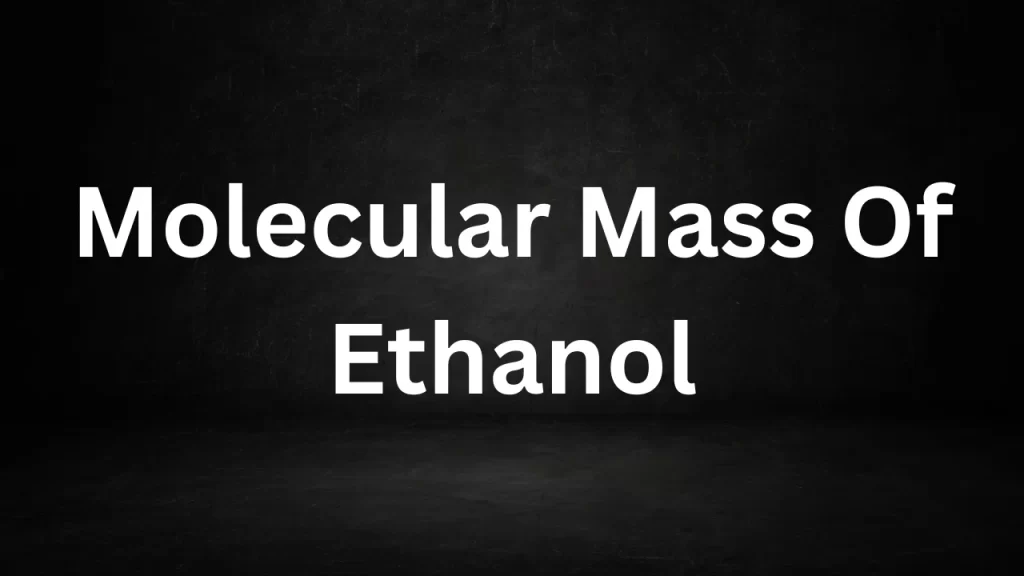Tag: molecular weight for ethanol
Molecular Mass Of Ethanol
Molecular Mass Of Ethanol: Ethanol, known for its widespread use as an alcohol in beverages and as a fuel additive, holds a central position in the realms of chemistry and industry.
Understanding the mole mass of ethanol (C2H5OH) is fundamental in comprehending its properties and applications. In this article, we will explore the concept of the molecular mass of ethanol, its calculation, and its significance in various fields.
Molecular Mass Of Ethanol
The Chemical Composition of Ethanol:
Ethanol, commonly known as alcohol, is a chemical compound comprising carbon (C), hydrogen (H), and oxygen (O) atoms. Its mole formula is C2H5OH, which signifies that each ethanol molecule consists of two carbon atoms, six hydrogen atoms, and one oxygen atom.
Calculating the Molecular Mass of Ethanol:
The molecular mass of a substance is its mass when considering one mole of that substance, expressed in grams per mole (g/mol). To calculate the molecular mass of ethanol, we consider the atomic masses of its constituent elements, carbon (C), hydrogen (H), and oxygen (O).
- The atomic mass of carbon (C) is approximately 12.01 g/mol.
- The atomic mass of hydrogen (H) is approximately 1.01 g/mol.
- The atomic mass of oxygen (O) is approximately 16.00 g/mol.
To find the mole mass of ethanol (C2H5OH), we sum the atomic masses of its constituent atoms:
Mole Mass of Ethanol (C2H5OH) (g/mol) = (2 × Atomic Mass of Carbon) + (6 × Atomic Mass of Hydrogen) + (1 × Atomic Mass of Oxygen)
Mole Mass of Ethanol ≈ (2 × 12.01 g/mol) + (6 × 1.01 g/mol) + (1 × 16.00 g/mol) ≈ 46.07 g/mol
So, the mole mass of ethanol (C2H5OH) is approximately 46.07 g/mol.
Significance of Molecular Mass in Chemistry:
- Stoichiometry: Mole mass is crucial in stoichiometry, facilitating the determination of reactant and product quantities in chemical reactions.
- Molarity (M): in chemistry is a concentration measure expressed as moles per liter (mol/L). Molar mass is crucial in molarity calculations for solutions.
- Chemical Equations: Mole mass plays a pivotal role in balancing chemical equations, ensuring the conservation of mass.
Practical Applications:
- Beverage Industry: Ethanol is a key component in alcoholic beverages, and understanding its molecular mass is essential for quality control and labeling.
- Fuel Production: Ethanol is used as a biofuel additive, and its properties, influenced by molecular mass, affect combustion and engine performance.
- Pharmaceuticals: Ethanol is used in the pharmaceutical industry, where its molecular mass plays a role in drug formulations and dosage calculations.
Conclusion:
The mole mass of ethanol (C2H5OH), approximately 46.07 g/mol, is a fundamental concept in chemistry with extensive applications in numerous industries. It is a cornerstone in stoichiometry, molarity calculations, and chemical equation balancing. Whether in the production of alcoholic beverages, as a biofuel, or in pharmaceutical formulations, understanding the mole mass of ethanol is vital for precision and efficiency in various processes. It underscores the pivotal role of chemistry in both everyday life and industrial applications.
Read More
- Molecular Mass of Ammonia
- Molecular Weight of H2O
- Molar Mass Of Sugar
- Molecular Weight Of Air
- Molar Mass Of Ag
Frequently Asked Questions (FAQs) Molecular Mass Of Ethanol
Q1: What is the molecular mass of ethanol (C2H5OH)?
A1: The mole mass of ethanol, often represented as C2H5OH, is approximately 46.07 grams per mole (g/mol). To calculate this value, you add the atomic masses of its constituent elements: carbon (C), hydrogen (H), and oxygen (O).
Q2: Why is knowing the molecular mass of ethanol important in chemistry?
A2: Understanding the mole mass of ethanol is essential in chemistry because it aids in stoichiometry calculations, determining concentrations (molarity) in solutions, and balancing chemical equations.
Q3: What practical applications are related to ethanol’s molecular mass?
A3: Ethanol has various practical applications, including its use in alcoholic beverages, as a biofuel additive, and in pharmaceutical formulations. Its molecular mass influences its properties and applications in these industries.
Q4: Does the molecular mass of ethanol change with temperature or pressure?
A4: The mole mass of ethanol (C2H5OH) remains constant regardless of temperature or pressure. It is a fixed value based on the atomic masses of carbon, hydrogen, and oxygen.
Q5: Is ethanol the same as ethyl alcohol?
A5: Yes, ethanol is often referred to as ethyl alcohol. It is the same chemical compound and is used interchangeably in various contexts, including in beverages and industrial applications.
